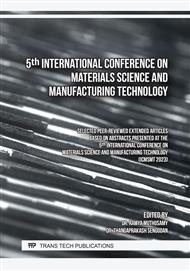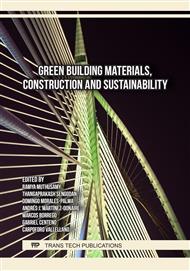[1]
B.T. Gibson, D.H. Lammlein, T.J. Prater, W.R. Longhurst, C.D. Cox, M.C. Ballun, K.J. Dharmaraj, G.E. Cook, A.M. Strauss, Friction stir welding: Process, automation, and control, J. Manuf. Process. 16 (2014) 56–73.
DOI: 10.1016/j.jmapro.2013.04.002
Google Scholar
[2]
R.S. Mishra, Z.Y. Ma, Friction stir welding and processing, Mater. Sci. Eng. R Reports. 50 (2005) 1–78.
DOI: 10.1016/j.mser.2005.07.001
Google Scholar
[3]
R. Nandan, T. DebRoy, H.K.D.H. Bhadeshia, Recent advances in friction-stir welding - Process, weldment structure and properties, Prog. Mater. Sci. 53 (2008) 980–1023.
DOI: 10.1016/j.pmatsci.2008.05.001
Google Scholar
[4]
G.K. Padhy, C.S. Wu, S. Gao, Friction stir based welding and processing technologies - processes, parameters, microstructures and applications: A review, J. Mater. Sci. Technol. 34 (2018) 1–38.
DOI: 10.1016/j.jmst.2017.11.029
Google Scholar
[5]
Y.J. Chao, X. Qi, W. Tang, Heat transfer in friction stir welding - Experimental and numerical studies, J. Manuf. Sci. Eng. Trans. ASME. 125 (2003) 138–145.
DOI: 10.1115/1.1537741
Google Scholar
[6]
Y.F. Sun, Y. Konishi, M. Kamai, H. Fujii, Microstructure and mechanical properties of S45C steel prepared by laser-assisted friction stir welding, Mater. Des. 47 (2013) 842–849.
DOI: 10.1016/j.matdes.2012.12.078
Google Scholar
[7]
D.H. Choi, C.Y. Lee, B.W. Ahn, J.H. Choi, Y.M. Yeon, K. Song, H.S. Park, Y.J. Kim, C.D. Yoo, S.B. Jung, Frictional wear evaluation of WC-Co alloy tool in friction stir spot welding of low carbon steel plates, Int. J. Refract. Met. Hard Mater. 27 (2009) 931–936.
DOI: 10.1016/j.ijrmhm.2009.05.002
Google Scholar
[8]
T.G. Santos, R.M. Miranda, P. Vilaça, Friction Stir Welding assisted by electrical Joule effect, J. Mater. Process. Technol. 214 (2014) 2127–2133. https://doi.org/10.1016/j.jmatprotec. 2014.03.012.
DOI: 10.1016/j.jmatprotec.2014.03.012
Google Scholar
[9]
Y. Bai, X. Jiang, S. Chen, W. Jiang, Y. Han, T. Yuan, X. Wang, Microstructure and properties of electrically assisted stationary shoulder friction stir welded Ti6Al4V, Sci. Technol. Weld. Join. 26 (2021) 377–388.
DOI: 10.1080/13621718.2021.1923441
Google Scholar
[10]
K.H. Song, T. Tsumura, K. Nakata, Development of microstructure and mechanical properties in laser-FSW hybrid welded inconel 600, Mater. Trans. 50 (2009) 1832–1837.
DOI: 10.2320/matertrans.M2009058
Google Scholar
[11]
S.L. Campanelli, G. Casalino, C. Casavola, V. Moramarco, Analysis and comparison of friction stir welding and laser assisted friction stir welding of aluminum alloy, Materials (Basel). 6 (2013) 5923–5941.
DOI: 10.3390/ma6125923
Google Scholar
[12]
X. Fei, Y. Ye, L. Jin, H. Wang, S. Lv, Special welding parameters study on Cu/Al joint in laser- heated friction stir welding, J. Mater. Process. Technol. 256 (2018) 160–171.
DOI: 10.1016/j.jmatprotec.2018.02.004
Google Scholar
[13]
S. Chen, H. Zhang, X. Jiang, T. Yuan, Y. Han, X. Li, Mechanical properties of electric assisted friction stir welded 2219 aluminum alloy, J. Manuf. Process. 44 (2019) 197–206.
DOI: 10.1016/j.jmapro.2019.05.049
Google Scholar
[14]
Y. Han, X. Jiang, S. Chen, T. Yuan, H. Zhang, Y. Bai, Y. Xiang, X. Li, Microstructure and mechanical properties of electrically assisted friction stir welded AZ31B alloy joints, J. Manuf. Process. 43 (2019) 26–34.
DOI: 10.1016/j.jmapro.2019.05.011
Google Scholar
[15]
D.K. Yaduwanshi, S. Bag, S. Pal, Effect of Preheating in Hybrid Friction Stir Welding of Aluminum Alloy, J. Mater. Eng. Perform. 23 (2014) 3794–3803. https://doi.org/.
DOI: 10.1007/s11665-014-1170-x
Google Scholar
[16]
H. Fujii, T. Tatsuno, T. Tsumura, M. Tanaka, K. Nakata, Hybrid friction stir welding of carbon steel, Mater. Sci. Forum. 580–582 (2008) 393–396. https://doi.org/10.4028/www.scientific.net/ msf.580-582.393.
DOI: 10.4028/www.scientific.net/msf.580-582.393
Google Scholar
[17]
A.I. Álvarez, V. Cid, G. Pena, J. Sotelo, D. Verdera, Assisted friction stir welding of carbon steel: Use of induction and laser as preheating techniques, Frict. Stir Weld. Process. VII. (2016) 117–126.
DOI: 10.1007/978-3-319-48108-1_13
Google Scholar
[18]
K. Elangovan, V. Balasubramanian, Influences of tool pin profile and tool shoulder diameter on the formation of friction stir processing zone in AA6061 aluminium alloy, Mater. Des. 29 (2008) 362–373.
DOI: 10.1016/j.matdes.2007.01.030
Google Scholar
[19]
C.H. Muralimohan, V. Muthupandi, K. Sivaprasad, Properties of Friction Welding Titanium- stainless Steel Joints with a Nickel Interlayer, Procedia Mater. Sci. 5 (2014) 1120–1129.
DOI: 10.1016/j.mspro.2014.07.406
Google Scholar
[20]
Y. Gao, T. Tsumura, K. Nakata, Dissimilar welding of titanium alloys to steels, Trans. JWRI. 41 (2012) 7–12.
Google Scholar
[21]
M.J. Jones, P. Heurtier, C. Desrayaud, F. Montheillet, D. Allehaux, J.H. Driver, Correlation between microstructure and microhardness in a friction stir welded 2024 aluminium alloy, Scr. Mater. 52 (2005) 693–697.
DOI: 10.1016/j.scriptamat.2004.12.027
Google Scholar
[22]
S.A. Khodir, T. Shibayanagi, Friction stir welding of dissimilar AA2024 and AA7075 aluminum alloys, Mater. Sci. Eng. B Solid-State Mater. Adv. Technol. 148 (2008) 82–87.
DOI: 10.1016/j.mseb.2007.09.024
Google Scholar
[23]
I. Galvão, J.C. Oliveira, A. Loureiro, D.M. Rodrigues, Formation and distribution of brittle structures in friction stir welding of aluminium and copper: Influence of shoulder geometry, Intermetallics. 22 (2012) 122–128
DOI: 10.1016/j.intermet.2011.10.014
Google Scholar
[24]
S. Shankar, K. Saw, S. Chattopadhyaya, S. Hloch, 2018. Investigation on different type of defects, temperature variation and mechanical properties of friction stir welded lap joint of aluminum alloy 6101-T6. 5.11 (2018) 24378-24386. https://doi.org/
DOI: 10.1016/j.matpr.2018.10.233
Google Scholar
[25]
V. Kumar, S. Chakraborty. Analysis of the surface roughness characteristics of EDMed components using GRA method. In Proceedings of the International Conference on Industrial and Manufacturing Systems (CIMS-2020) Optimization in Industrial and Manufacturing Systems and Applications (2022) 461-478. Springer International Publishing.
DOI: 10.1007/978-3-030-73495-4_32
Google Scholar
[26]
Salloomi, K. N., Hussein, F. I., & Al-Sumaidae, S. N. (2020). Temperature and stress evaluation during three different phases of friction stir welding of AA 7075-T651 alloy. Modelling and simulation in engineering, (2020) 1-11.
DOI: 10.1155/2020/3197813
Google Scholar
[27]
Kumar, D., Alam, M. P., & Sinha, A. N. (2023). Numerical and Experimental Analysis of Friction Stir Welding of Aluminum Alloy AA2024-T4. In Recent Trends in Mechanical Engineering: Select Proceedings of PRIME 2021 (2023) 35-44. Singapore: Springer Nature Singapore.
DOI: 10.1007/978-981-19-7709-1_4
Google Scholar



